How To Find Wacc In Excel
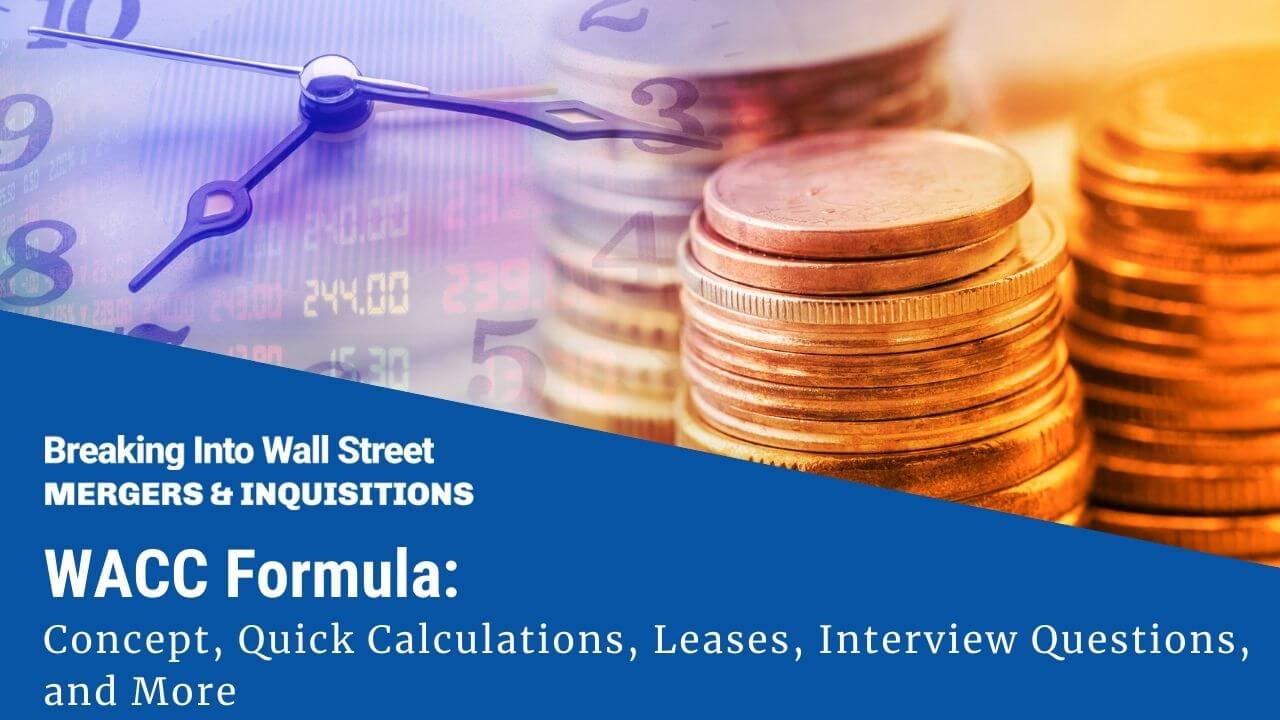
If I had to pick a single concept in corporate finance nigh deserving of the "much ado about goose egg" laurels, it would be WACC (the Weighted Average Price of Capital).
In a standard discounted cash menstruum (DCF) model based on Unlevered Free Greenbacks Flow, WACC represents the Discount Charge per unit: the expected or required annualized render from investing in the visitor you're valuing.
Many textbooks and bookish sources spend an insane corporeality of time and energy on detailed calculations for this number.
Banks sometimes exercise the aforementioned, only they're a bit less extreme – and at least they're getting paid for it.
The WACC formula, which is what everyone seems to Google, is easy:
WACC = Cost of Equity * % Disinterestedness + Cost of Debt * (one – Tax Rate) * % Debt + Cost of Preferred Stock * % Preferred Stock
And if you want to be fancy and add Leases into the mix, it becomes:
WACC Including Leases = Cost of Equity * % Equity + Cost of Debt * (1 – Tax Rate) * % Debt + Cost of Leases * (1 – Taxation Rate) * % Leases + Cost of Preferred Stock * % Preferred Stock
As with many other financial concepts, the formula is simple; the real difficulty is determining the right inputs with limited fourth dimension.
WACC Formula: Video Tutorial and Excel Templates
If you'd adopt to watch rather than read, you tin can get this [very long] tutorial below:
Table of Contents:
- ii:08: Part i: The Big Idea Backside the Disbelieve Rate
- three:15: The WACC Formula
- 4:47: Part 2: Quick-and-Dirty WACC
- x:xl: Function iii: More Complex Calculations
- eighteen:25: Cost of Disinterestedness and WACC
- 22:57: Function 4: Leases in WACC: What to Practice
- 28:11: Part 5: WACC Interview Questions
- 31:33: Epitomize and Summary
And hither are the accompanying Excel files:
- Sample WACC Adding for Steel Dynamics, With and Without Leases
- WACC Formula – Slide Presentation
- Steel Dynamics 10-K with Relevant Areas Highlighted
The Big Idea Behind the WACC Formula
The DCF model is based on projecting companies' cash flows years or decades into the future.
But since $i,000 in 10 years is worth less than $one,000 today – as we could invest it today and earn more by and so – nosotros need to discount these future greenbacks flows to their Present Value.
For a standard DCF based on Unlevered Gratis Cash Flow, i.e., a company'due south core-business cash flows available to all investors in the company, WACC is the appropriate Disbelieve Rate:
WACC = Cost of Equity * % Equity + Cost of Debt * (1 – Tax Charge per unit) * % Debt + Toll of Preferred Stock * % Preferred Stock
The Price of Disinterestedness represents the potential returns from the company's stock price increasing and its dividends.
The Costs of Debt and Preferred Stock stand for the potential returns from the interest or dividends they pay and the changing market value of these items.
If you invest proportionally in the company'southward capital structure, WACC represents what yous might earn, annualized, over the long term.
For example, peradventure you're valuing a company with 80% Disinterestedness, twenty% Debt, and a 25% Tax Charge per unit.
If you desire to invest $1,000, a proportional investment would exist $800 in its Equity (the common shares) and $200 in its Debt.
This visitor'southward stock price has increased past 8% per year over the long term, on boilerplate, and its dividends have produced an additional two% in annualized returns.
This company's yield on its Debt is six%, and like companies yield around the same 6%.
Therefore, the Price of Equity is ii% + 8% = x%, and the pre-revenue enhancement Cost of Debt is 6%.
Since the interest paid on Debt is tax-deductible, information technology "costs" the visitor less than six% per yr, so we multiply past (i – Taxation Rate), or (1 – 25%), here:
WACC = x% * eighty% + 20% * 6% * (1 – 25%) = eight.9%
And so, in theory, yous'll earn $89 per twelvemonth over the long term from this investment… but near of these returns come from the visitor'due south stock price going up, then you won't see them in greenbacks until you sell your investment.
Also, anything could happen in a single year or fifty-fifty a few years, and then yous could easily lose money in the short term.
Because of all these issues, it'southward all-time to think of WACC as a metric where yous should aim to exist "roughly correct" rather than "precisely wrong."
The WACC formula should produce very dissimilar results for a pre-revenue startup vs. a mature, profitable company, but the differences are more difficult to pin down inside these categories.
WACC Formula: The Quick-and-Dingy Method
Fortunately, you can make a quick approximation for WACC with nigh 5 minutes of work.
First past looking up the market cap, or Equity Value, of the visitor you're valuing and finding its Debt and Preferred Stock figures in its filings (example for Steel Dynamics below):
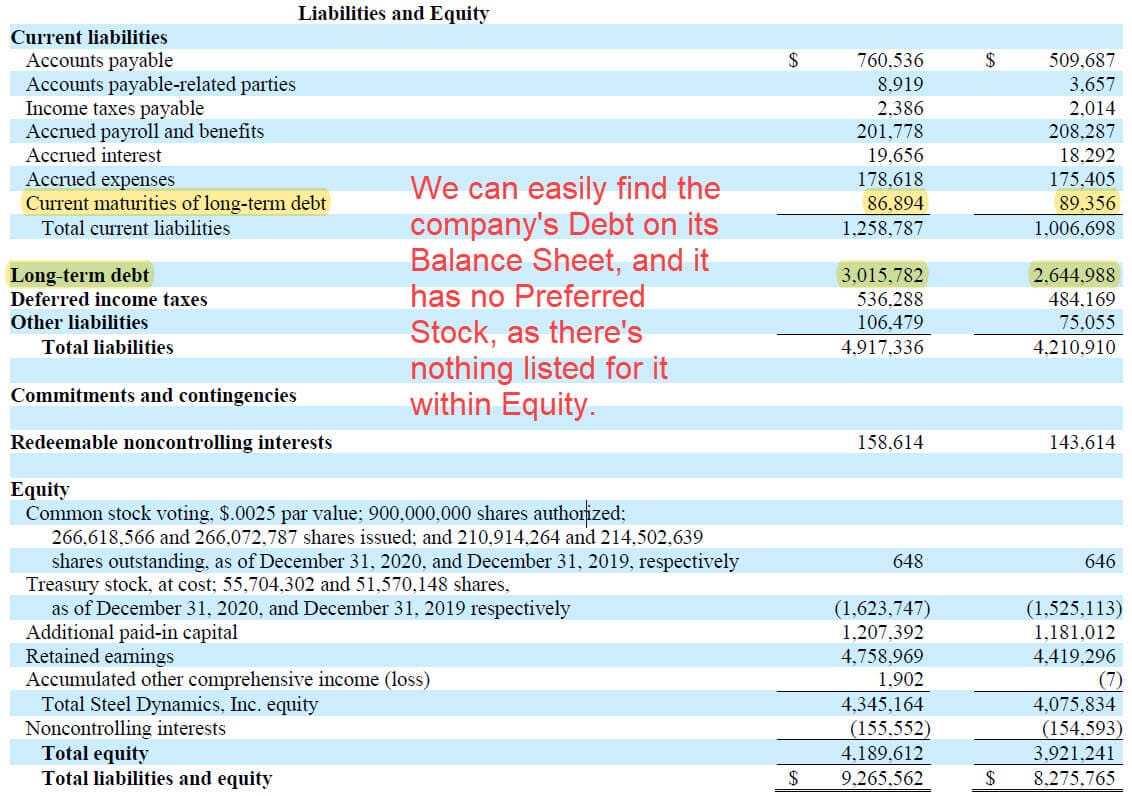
You can use these numbers to summate the % Disinterestedness, % Debt, and % Preferred Stock in its capital letter structure:

To judge the Cost of Debt, you can take the Interest Expense on the annual Income Statement and dissever it by the average Debt rest over the catamenia:
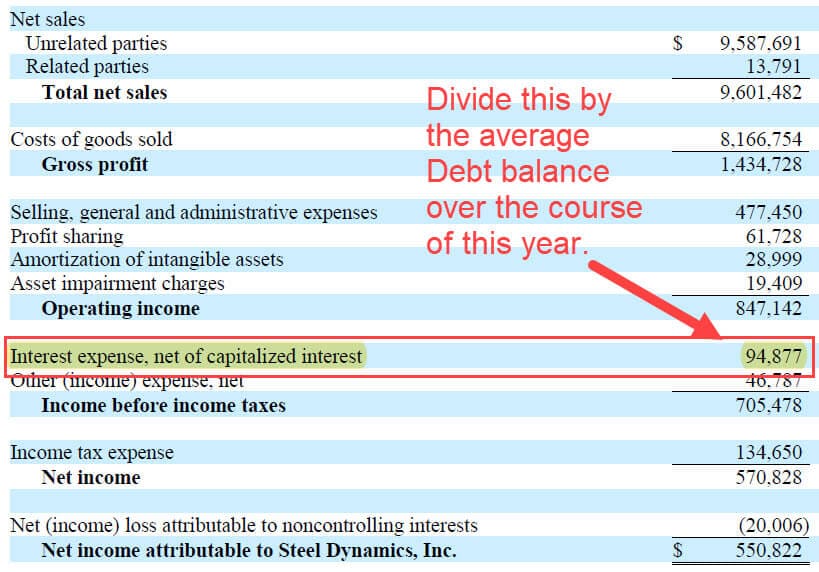
If you're using a quarterly or half-year study, you lot'll have to annualize this figure.
The same approach applies to Preferred Stock; y'all can oft skip this step because Preferred Stock is rare for well-nigh modern companies.
Estimating the Cost of Equity is trickier, simply the most common method is:
Cost of Equity = Risk-Free Charge per unit + Equity-Risk Premium * Levered Beta
The idea is to take what yous could earn in "hazard-complimentary" authorities bonds – the Risk-Free Charge per unit – add the additional return offered by the stock marketplace – the Equity Run a risk Premium – and so multiply by a gene representing this company's volatility relative to the market's – Levered Beta.
In theory, this represents what the visitor's stock price + dividends "should" return on an annualized basis over the long term.
You tin can discover the Take chances-Free Rate based on 10-twelvemonth government bail yields in the company's country (like shooting fish in a barrel to look up online), and Disinterestedness Risk Premium estimates are adequately piece of cake to find every bit well:
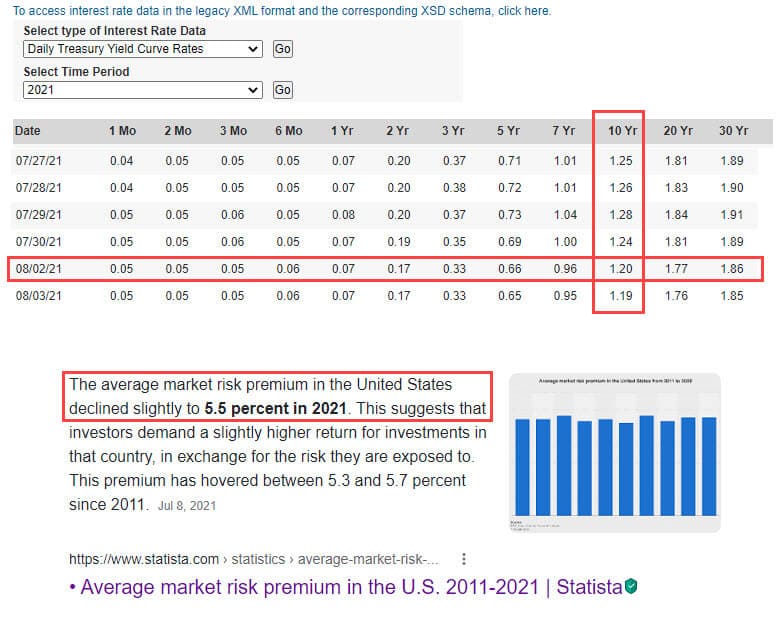
To find Levered Beta for the company you're valuing, you can use sources like Finviz or Yahoo Finance (or paid services such equally Capital IQ if you have access):
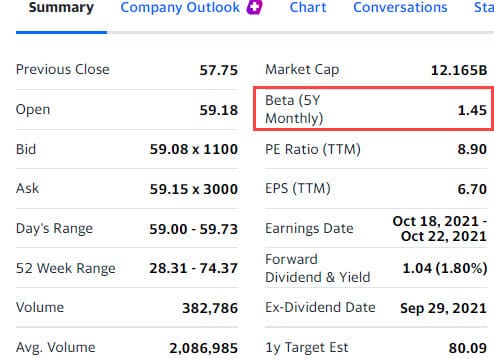
And in a few minutes of work, you tin turn the WACC formula into a crude guess for this company:
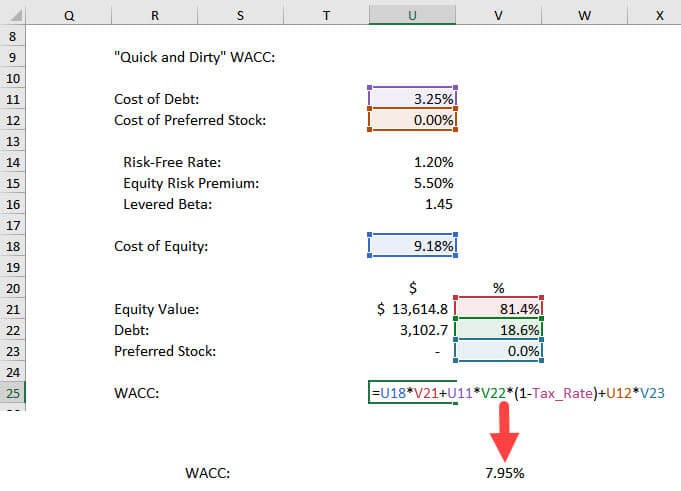
WACC Formula: The More than Complex Method
The method above is elementary, efficient, and produces decent results, so why go across it?
Like everything else in financial modeling, you can make the WACC formula as piece of cake or every bit complicated as yous want, and banks like to brand things complicated.
The main reasons to do so are:
- To become a proper range of values for WACC. We want to know if a company'south Discount Rate should exist betwixt 10% and 12% or between 6% and viii%, for example.
- It's more accurate to calculate the Costs of Debt and Preferred Stock past factoring in their market values. And it may be more accurate to estimate the hazard and potential returns in the Cost of Disinterestedness past analyzing the comparable companies.
We'll start with the Toll of Debt since that's easier to explicate.
With this one, information technology's best to wait up the fair value or fair market value of the Debt and use it in the uppercase structure calculations (equally opposed to the book value, which appears on the visitor's Balance Sheet).
Y'all tin likewise use these fair values to summate the yield to maturity (YTM) of the Debt, which reflects premiums and discounts (if the Debt trades at a disbelieve to its par value, the investor will earn more than than the stated coupon rate if they hold it until maturity).
Here's an instance for Steel Dynamics (based on the annual filings since it doesn't close the fair value of Debt in detail in its acting filings):
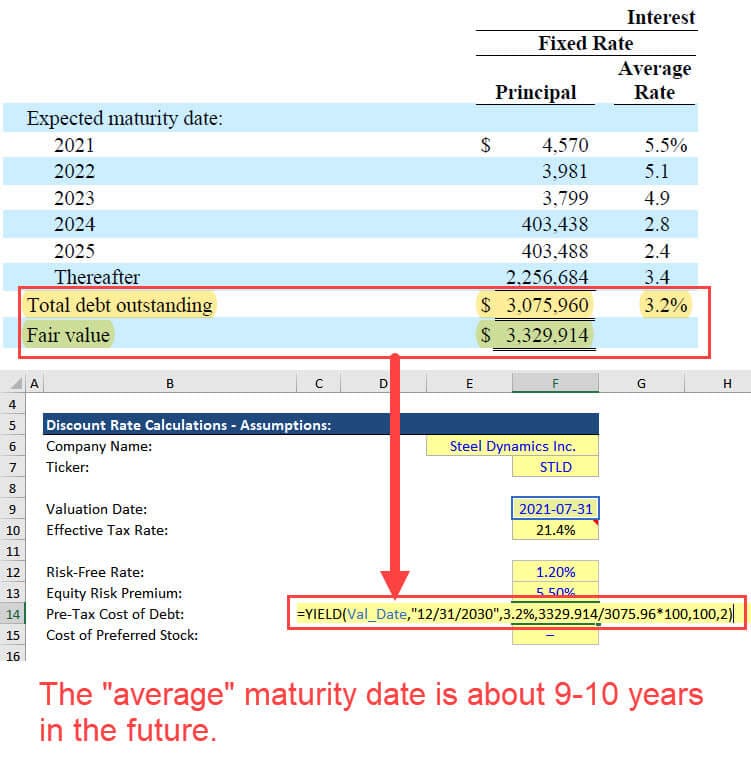
This "slightly more accurate" method produces 2.22% for the Cost of Debt rather than 3.25%.
That may seem similar a big divergence, but the company uses just ~20% Debt, then it barely changes WACC.
There are other ways to estimate the Cost of Debt; for example, you could take the Risk-Costless Rate and add an estimated credit default spread based on the company'due south credit rating.
You could likewise look at the YTMs on like debt issuances from comparable companies, but this one requires a lot more work (encounter below).
Cost of Disinterestedness in the WACC Formula: Added Complications
There are several ways to brand the Cost of Equity calculation more than complicated, but the master one is to go through a process known as un-levering and re-levering Beta.
Rather than using the company's own historical Beta – how it performed against its own stock-market index – information technology may be more accurate to measure risk and potential returns based on other, like companies in the industry.
All companies accept ii types of chance: risk from operating their core business organization and run a risk from leverage (Debt).
The "Beta" figures you find on sites similar Yahoo Finance and Finviz include both risks, so they are known as "Levered Beta."
To separate the business risk, the first step is to find a ready of comparable companies and await up the Debt, Equity, Preferred Stock, Beta, and Tax Rate figures for each one:
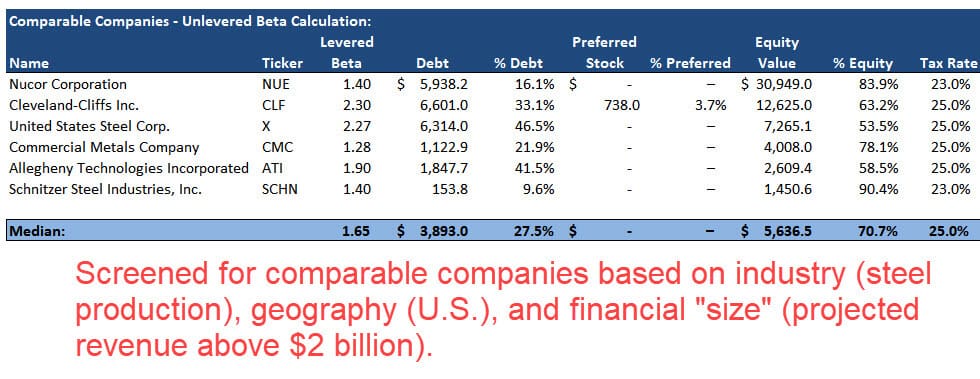
Nosotros can then "united nations-lever" Beta for each company by reducing it based on the visitor's leverage:
Unlevered Beta = Levered Beta / (1 + Debt / Equity * (1 – Tax Rate) + Preferred / Disinterestedness)
Dividing by a term that starts with "1 +" ensures that Unlevered Beta will always be less than or equal to Levered Beta.
Once we have this for all the peer companies, we can "re-lever Beta" by post-obit the procedure in the opposite direction for Steel Dynamics:
Re-Levered Beta = Unlevered Beta * (1 + Debt / Equity * (1 – Tax Rate) + Preferred / Equity)
"Re-levering" Beta similar this takes the inherent business risk from the comparable companies and and then adjusts information technology up forthis company's risk from leverage.
But there is one question: do we use the company's electric current capital structure, or its "optimal" or "targeted" structure?
The argument for the latter is that over time, whatsoever company will kickoff to resemble other, similar companies in the industry in terms of capital construction.
And then, it may be more accurate to use the median percentages from the comparable companies instead. We utilise both approaches here:
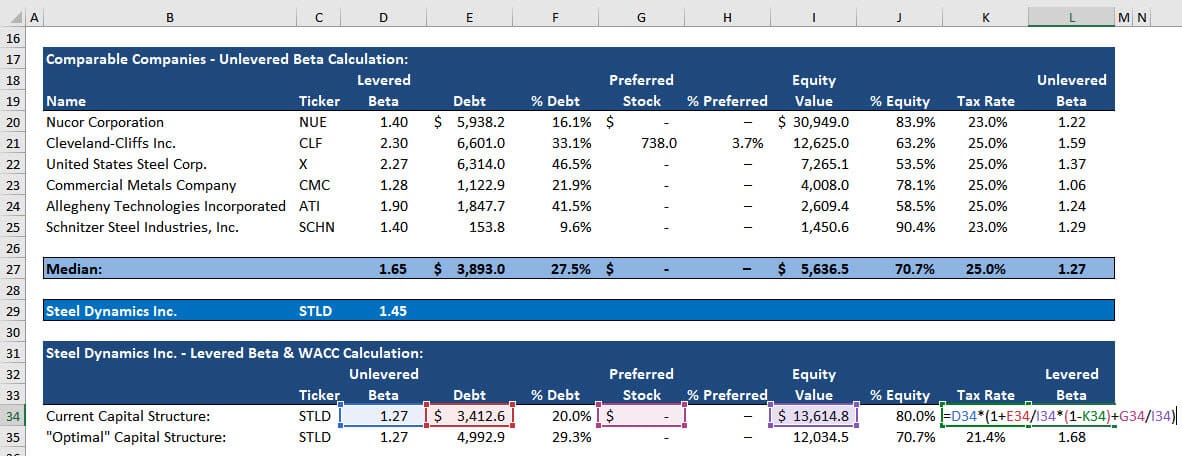
As a outcome of these dissimilar calculation methods for Beta, we at present have three different ways to calculate the Toll of Disinterestedness and WACC:
- Method #1: Utilize the company's own historical Beta and its current capital structure.
- Method #2: Base of operations Beta on the comparable companies simply utilize the visitor's current capital construction.
- Method #3: Base Beta and the capital structure on the comparable companies.
At that place is no "all-time" method; the point is to establish a plausible range of values.
Here are the results for Steel Dynamics:

As a dominion of pollex, a practiced range of WACC values for mature companies spans virtually 2-3% from the minimum to the maximum.
And then, 10-12% or 6-9% would be fine.
But 5-ten% might be a bit too broad, and five-15% would be too broad to be useful.
(Exceptions apply in emerging markets and for more speculative companies.)
How to Deal with Leases in the WACC Formula
We published a detailed tutorial on lease accounting, then you should refer to that for the fundamentals.
The principal issue here is that lease accounting worldwide changed in a major way in 2019, and people are still figuring out how to deal with leases in models and valuations.
At a high level:
- Companies oftentimes group Finance Leases with their Debt balances, and they tend to be quite small, so they rarely make a pregnant impact on WACC. Historically, people ignored them and didn't suspension them out as split items.
- Since Operating Leases moved onto companies' Balance Sheets in 2019, at that place have been many questions about how to treat them in the DCF and the WACC formula. They are much bigger than Finance Leases for well-nigh companies, which makes the decision more pregnant.
Our recommendation is to not count Operating Leases every bit a form of capital in the WACC formula and to deduct the full Operating Lease Expense in the Free Cash Flow projections.
Regardless of how a company classifies its leases, the lease expense even so represents a greenbacks outflow resulting from the company's business operations, and the DCF is based on cash inflows and outflows from the core concern.
A visitor's leases are mostly operational decisions based on where it needs employees and production capacity.
Therefore, it doesn't brand much sense to say that leases correspond "outside investors" in the same style Debt and Preferred Stock do.
But if you wanted to, you could count Operating Leases as capital by modifying the Unlevered Beta, Re-Levered Beta, and WACC formulas to include an extra term (we separated Finance Leases from Debt and added them to Operating Leases here):
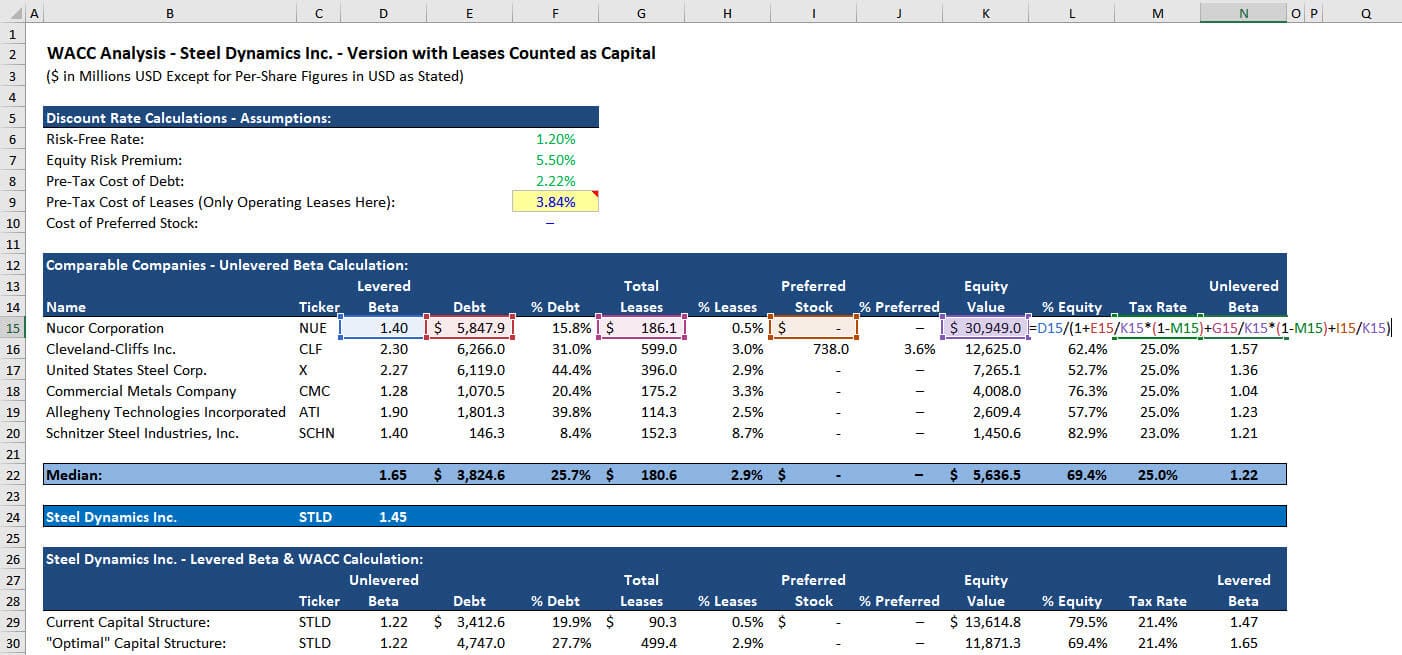
In the WACC formula, y'all can find the Pre-Tax Cost of Leases by looking up the discount rate the company uses to calculate its Lease Liabilities in its filings:

In this example, the results barely change:
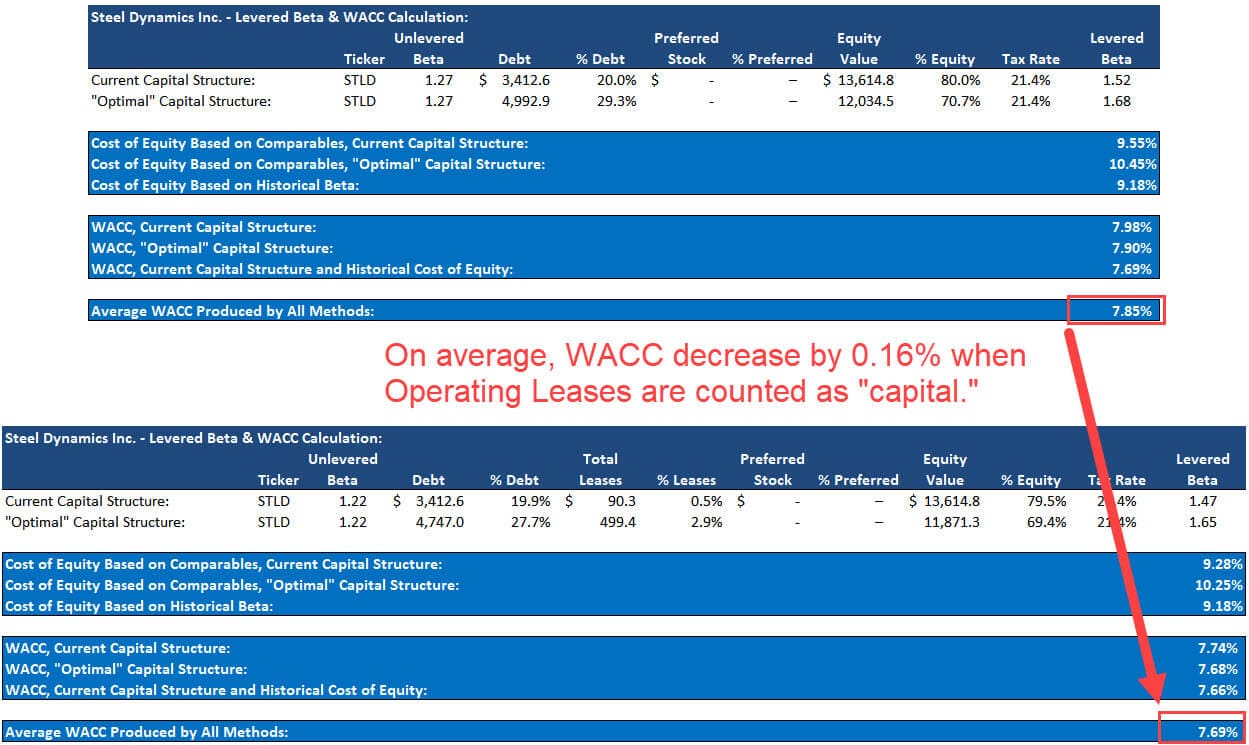
WACC decreases by 0.16% because Leases are, finer, another low-cost funding source for this company.
If nosotros practise this in the WACC calculation, we besides need to modify the Enterprise Value calculations to include Leases and add back or exclude the full Charter Expense in Unlevered Free Cash Menses.
The visitor's implied value tends to increase because the lower WACC affects everything more than the subtraction for the Charter liability in the Enterprise value bridge.
But it's extra work that makes almost no departure in the DCF output, and then it'southward hard to recommend this approach in a valuation.
Interview Questions About WACC
The near mutual interview questions here are variations of:
- "Detail 10 goes upward. How does WACC change?"
- "Item Y goes downwardly. How does WACC change? What about the implied value from a DCF?"
This chart sums up the most common topics:
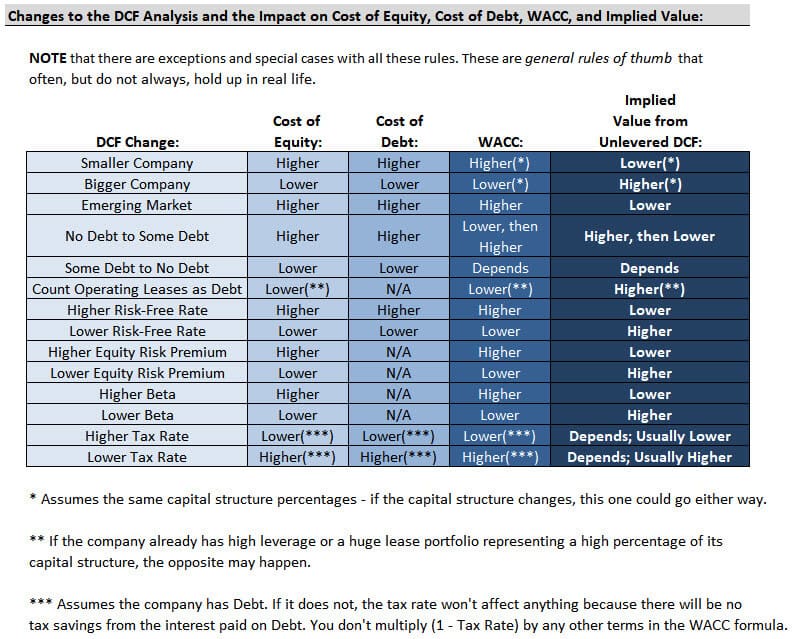
To understand these points intuitively, call up near the risk and potential returns for each component of WACC.
For example, smaller companies and ones in emerging markets tend to be riskier but besides have higher growth potential than larger companies and ones in developed markets.
Therefore, yous'd wait WACC to be higher, forth with components like the Cost of Equity and Price of Debt.
Some of these points are a bit tricky; increased Debt, for example, tends to reduce WACC at first but then increases information technology by a certain level.
The rationale is that at minimal or depression Debt levels, the cost advantages of Debt outweigh its drawbacks (the added risk of bankruptcy), just in a higher place a sure level, the bankruptcy risk starts to boss everything else.
Annotation that you won't "see" a modify like this directly in a model unless you make the Price of Debt change as the company'southward Debt % changes.
For Further Learning About WACC
If you want to learn more most DCF models and concepts similar WACC and get a stride-by-pace walkthrough, sign up for our free financial modeling tutorials.
These tutorials comprehend a iii-role series on the valuation of Michael Colina, a retailer in Australia and New Zealand, and they explain the unabridged process from starting time to end.
And if you want in-depth case studies backed by real-world information and enquiry, the Fiscal Modeling Mastery form delves into valuation/DCF analysis in even greater detail.
A few modules are dedicated to valuation and DCF analysis, and there are examples of visitor valuation in other industries (steel, pharmaceuticals, building materials, solar power, online subscription services, etc.).
Source: https://mergersandinquisitions.com/wacc-formula/

0 Response to "How To Find Wacc In Excel"
Post a Comment